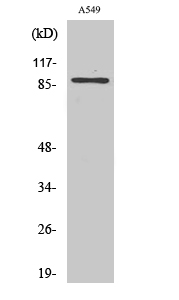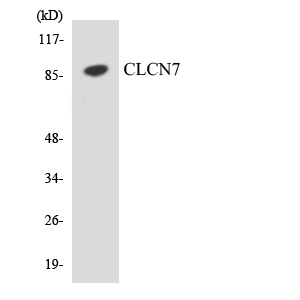CLC-7 Polyclonal Antibody
- Catalog No.:YT0961
- Applications:WB;ELISA
- Reactivity:Human;Mouse;Rat
- Target:
- CLC-7
- Gene Name:
- CLCN7
- Protein Name:
- H(+)/Cl(-) exchange transporter 7
- Human Gene Id:
- 1186
- Human Swiss Prot No:
- P51798
- Mouse Gene Id:
- 26373
- Mouse Swiss Prot No:
- O70496
- Rat Gene Id:
- 29233
- Rat Swiss Prot No:
- P51799
- Immunogen:
- The antiserum was produced against synthesized peptide derived from human CLCN7. AA range:10-59
- Specificity:
- CLC-7 Polyclonal Antibody detects endogenous levels of CLC-7 protein.
- Formulation:
- Liquid in PBS containing 50% glycerol, 0.5% BSA and 0.02% sodium azide.
- Source:
- Polyclonal, Rabbit,IgG
- Dilution:
- WB 1:500 - 1:2000. ELISA: 1:40000. Not yet tested in other applications.
- Purification:
- The antibody was affinity-purified from rabbit antiserum by affinity-chromatography using epitope-specific immunogen.
- Concentration:
- 1 mg/ml
- Storage Stability:
- -15°C to -25°C/1 year(Do not lower than -25°C)
- Other Name:
- CLCN7;H(+)/Cl(-) exchange transporter 7;Chloride channel 7 alpha subunit;Chloride channel protein 7;ClC-7
- Observed Band(KD):
- 90kD
- Background:
- chloride voltage-gated channel 7(CLCN7) Homo sapiens The product of this gene belongs to the CLC chloride channel family of proteins. Chloride channels play important roles in the plasma membrane and in intracellular organelles. This gene encodes chloride channel 7. Defects in this gene are the cause of osteopetrosis autosomal recessive type 4 (OPTB4), also called infantile malignant osteopetrosis type 2 as well as the cause of autosomal dominant osteopetrosis type 2 (OPTA2), also called autosomal dominant Albers-Schonberg disease or marble disease autosoml dominant. Osteopetrosis is a rare genetic disease characterized by abnormally dense bone, due to defective resorption of immature bone. OPTA2 is the most common form of osteopetrosis, occurring in adolescence or adulthood. [provided by RefSeq, Jul 2008],
- Function:
- disease:Defects in CLCN7 are a cause of autosomal dominant osteopetrosis type 2 (OPTA2) [MIM:166600]; also called autosomal dominant Albers-Schonberg disease or marble disease autosoml dominant. OPTA2 is the most common form of osteopetrosis, occurring in adolescence or adulthood. It is characterized by sclerosis, predominantly involving the spine, the pelvis, and the skull base.,disease:Defects in CLCN7 are the cause of osteopetrosis autosomal recessive type 4 (OPTB4) [MIM:611490]; also called infantile malignant osteopetrosis type 2. Osteopetrosis is a rare genetic disease characterized by abnormally dense bone, due to defective resorption of immature bone. The disorder occurs in two forms: a severe autosomal recessive form occurring in utero, infancy, or childhood, and a benign autosomal dominant form occurring in adolescence or adulthood.,function:Mediates the exchange of chloride io
- Subcellular Location:
- Lysosome membrane ; Multi-pass membrane protein .
- Expression:
- Brain and kidney.
- June 19-2018
- WESTERN IMMUNOBLOTTING PROTOCOL
- June 19-2018
- IMMUNOHISTOCHEMISTRY-PARAFFIN PROTOCOL
- June 19-2018
- IMMUNOFLUORESCENCE PROTOCOL
- September 08-2020
- FLOW-CYTOMEYRT-PROTOCOL
- May 20-2022
- Cell-Based ELISA│解您多样本WB检测之困扰
- July 13-2018
- CELL-BASED-ELISA-PROTOCOL-FOR-ACETYL-PROTEIN
- July 13-2018
- CELL-BASED-ELISA-PROTOCOL-FOR-PHOSPHO-PROTEIN
- July 13-2018
- Antibody-FAQs
- Products Images

- Western Blot analysis of A549 cells using CLC-7 Polyclonal Antibody diluted at 1:500

- Western blot analysis of CLCN7 Antibody. The lane on the right is blocked with the CLCN7 peptide.

- Western blot analysis of the lysates from COLO205 cells using CLCN7 antibody.



